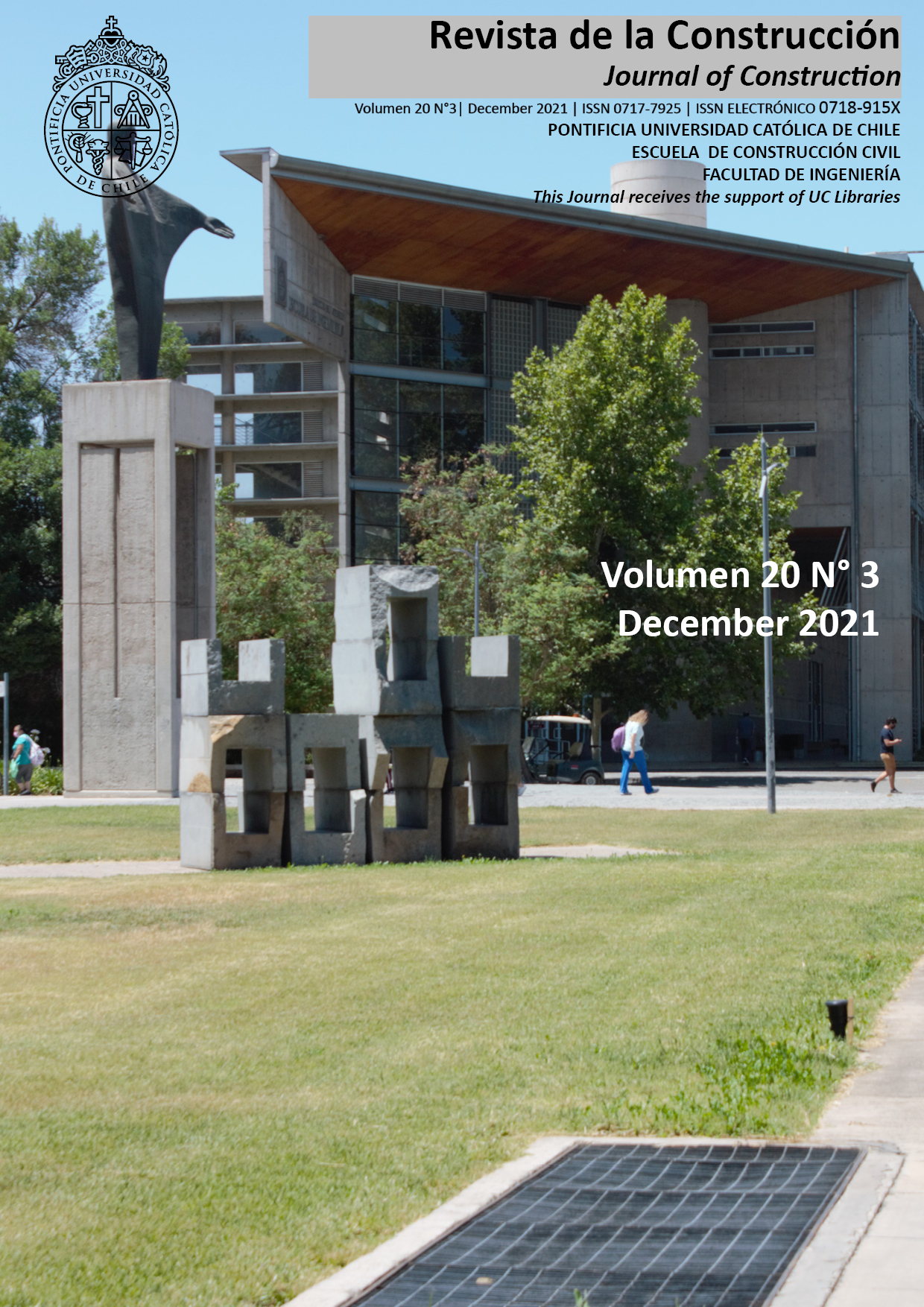The deformation characteristics of buried HDPE transfer lines in trenches under the effect of temperature
DOI:
https://doi.org/10.7764/RDLC.20.3.452Keywords:
buried pipe, deformation behaviour, high-density polyethylene, silica sand, thermal conditionsAbstract
Today, the use of high-density polyethylene (HDPE) transfer lines is increasing day by day for drinking water, wastewater, sewerage networks, rainwater drainage lines, water transport structures, and natural energy sources, etc. In this study, flexible HDPE pipes were embedded in a trench to expose them to variable relative density and different thermal conditions so that the resulting deformation behavior could be investigated. Displacements and elastic strain values in the crown and spring line regions were measured. The main aim of this research was to determine the behavior of HDPE pipes under temperature effects within the framework of geotechnical principles to reflect real field conditions. As a result, pipes subject to vertical loading were tested under different relative density and thermal conditions. In the experiments carried out in a silica sandy trench, the deformations increased due to an increase in relative density. The maximum displacements and bending moment values were obtained at 50°C, which was the maximum thermal condition applied. An increase in temperature increased the deformation values due to the resulting decrease in the modulus of elasticity.
Downloads
References
Al-Mosawe, M. J., Said, A. I., & Dawood, A. O. (2020). Effect of bedding compaction on the behavior of buried plain concrete pipes. Key Engineering Materials, 857, 89–98. https://doi.org/10.4028/www.scientific.net/KEM.857.89
Alawaji, H. A. (2004). Performance of buried HDPE pipes at elevated temperatures. Electronic Journal of Geotechnical Engineering, 1(19).
ASTM D2321-00. (2000). ASTM D2321-00, Standard Practice for Underground Installation of Thermoplastic Pipe for Sewers and Other Gravity-Flow Applications. https://doi.org/10.1520/D2321-00
ASTM D2487_06. (2006). ASTM D2487 - 06, Standard Practice for Classification of Soils for Engineering Purposes (Unified Soil Classification System). https://doi.org/10.1520/D2487-06
Callister, W. D., & Rethwisch, D. G. (2015). Fundamentals of Materials Science and Engineering, An Integrated Approach (5th ed.). Wiley.
Cheng, J. J. (2008). Mechanical and chemical properties of high density polyethylene: effects of microstructure on creep characteristics [PhD Thesis, Univer-sity of Waterloo, Ontario, Canada]. http://hdl.handle.net/10012/4121
Gabriel, L. H., & Moran, E. T. (1998). Service life of drainage pipe. National Academy Press.
Howard, A., & Rahman, S. (2020). Review of design methods in AWWA manuals for various flexible pipe. Pipelines 2020, 336–345. https://doi.org/10.1061/9780784483213.037
Kapischke, M., & Pries, A. (2014). Theodor Billroth’s vision and Karl Ziegler’s action: Commemoration of the 40th day of death and the 50th anniversary of conferment of Nobel Prize for Chemistry of Karl Ziegler. Surgery (United States), 155(2), 347–349. https://doi.org/10.1016/j.surg.2013.10.022
Khademi-Zahedi, R., & Alimouri, P. (2018). Finite element analysis to the effect of thermo-mechanical loads on stress distribution in buried polyethylene gas pipes jointed by electrofusion sockets, repaired by PE patches. Energies, 11(10). https://doi.org/10.3390/en11102818
Krishnaswamy, R. K. (2005). Analysis of ductile and brittle failures from creep rupture testing of high-density polyethylene (HDPE) pipes. Polymer, 46(25), 11664–11672. https://doi.org/10.1016/j.polymer.2005.09.084
Laidlaw, T. C. (1999). Influence of local support on corrugated HDPE pipe. MSc Thesis, The University of Western Ontario, Faculty of Graduate Studies.
Lepoutre, P. (2013). The manufacture of polyethylene. X-Polymers-J-Polyethylene, Transpak Industries Ltd.
Li, Z., Zhu, H., Kong, X., & Seibi, A. (2012). Combined effect of temperature and soil load on buried HDPE pipe. Advanced Materials Research, 452–453, 1169–1173. https://doi.org/10.4028/www.scientific.net/AMR.452-453.1169
Liang, J. Z. (2019). Melt strength and drawability of HDPE, LDPE and HDPE/LDPE blends. Polymer Testing, 73, 433–438. https://doi.org/10.1016/j.polymertesting.2018.12.007
Merah, N., Saghir, F., Khan, Z., & Bazoune, A. (2006). Effect of temperature on tensile properties of HDPE pipe material. Plastics, Rubber and Compo-sites, 35(5), 226–230. https://doi.org/10.1179/174328906X103178
Patel, B. D., & Srinivas, A. R. (2012). Validation of experimental strain measurement technique and development of force transducer. International Journal of Scientific & Engineering Research, 3(10). http://www.ijser.org
Polat, N. (2020). Investigation of deformation properties of high-density polyethylene pipes under thermal effects. MSc Thesis, Graduate School of Natural and Applied Sciences, Aksaray University, Aksaray, Turkey.
Sadr-Al-Sadati, S. A., & Jalili Ghazizadeh, M. (2019). The experimental and numerical study of water leakage from high-density polyethylene pipes at elevated temperatures. Polymer Testing, 74, 274–280. https://doi.org/10.1016/j.polymertesting.2019.01.014
Seymour, R. (1989). Pioneers in Polymer Science. In F. B. Seymour (Ed.), Chemists and Chemistry (1st ed.). Springer Netherlands. https://doi.org/10.1007/978-94-009-2407-9
Shaidullin, N. M., Salakhov, I. I., Borisenko, V. N., Tavtorkin, A. N., & Nifant’ev, I. E. (2020). Structural, rheological, and mechanical properties of binary compounds based on high-density polyethylene and linear low-density polyethylene. Russian Journal of Applied Chemistry, 93(8), 1179–1187. https://doi.org/10.1134/S1070427220080108
Tarani, E., Terzopoulou, Z., Bikiaris, D. N., Kyratsi, T., Chrissafis, K., & Vourlias, G. (2017). Thermal conductivity and degradation behavior of HDPE/graphene nanocomposites: pyrolysis, kinetics and mechanism. Journal of Thermal Analysis and Calorimetry, 129(3), 1715–1726. https://doi.org/10.1007/s10973-017-6342-0
Tavman, I., Aydoğdu, Y., Kök, M., Turgut, A., & Ezan, A. (2011). Measurement of heat capacity and thermal conductivity of HDPE/expanded graphite nanocomposites by differential scanning calorimetry. Archives of Materials Science, 50(1), 56–60. www.archivesmse.org
Terzi, N. U. (2007). Gömülü borulara etkiyen düşey ve yatay yüklerin boru stabilitesine olan etkilerinin araştırılması. PhD Thesis, Yildiz Technical Universi-ty, Graduate School of Natural and Applied Sciences, Istanbul, Turkey.
Trautmann, C. H., & O’Rourke, T. D. (1985). Lateral force-displacement response of buried pipe. Journal of Geotechnical Engineering, 111(9), 1077–1092. https://doi.org/10.1061/(ASCE)0733-9410(1985)111:9(1077)
Ural, N., & Gergin, A. (2020). Foundation design on problematic soils with high underground water level. Revista de La Construccion, 19(3), 233–245. https://doi.org/10.7764/RDLC.19.3.233








